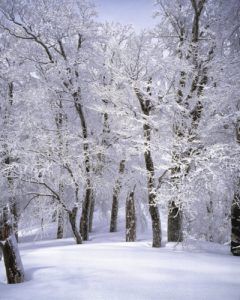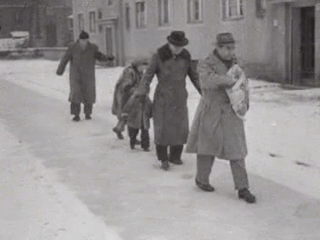 Lately, I’ve been thinking about climate change and how the expectations of what winter, or any other season, will be like in the average year are changing.
Lately, I’ve been thinking about climate change and how the expectations of what winter, or any other season, will be like in the average year are changing.
The official graphs and charts that show how rapidly the average temperatures are climbing from one decade to the next are obviously quite important, but I think there’s something to be said for listening to and writing down anecdotes about the climate as well. Future generations might like to know what things were like when we were young and the Earth was colder.
My first clear memories of winter happened in the early 1990s. My family lived in Wyoming then, and our town was nestled so close to the Rocky Mountains that we regularly saw heavy snowstorms between the months of October and May.
I think my family was snowed in at least once during these storms. There is only so much plowing that can be done before the blizzard wins and everyone needs to stay off those slippery roads for safety reasons.
Before I tell this next story, keep in mind that I was always petite for my age growing up. Not every child would have been light enough to pull this off, but I do have memories of walking on top of frozen snowbanks when I was about seven or eight years old. The snow had melted a little, and when it refroze it created a sort of crust on top of it that I could just barely walk on top of. I felt like a superhero and was a little disappointed the next winter when I realized that I was too heavy to do that trick again. (The funny thing was, I remained one of smallest kids in my class all the way through to high school graduation!)
In the mid-1990s, my family moved back to Ohio. Every year we’d generally have at least a few days cancelled due to snow or ice storms. Ohio was a less snowy place than Wyoming, so I don’t remember quite as many times when the roads were closed due to storms as they did when we lived out west.
I do remember feeling a little surprised by the lessening amounts of snow as the years rolled on. Part of it was almost certainly due to the fact that I was growing into my full adult height and viewing snowdrifts from that perspective instead of the point of view of a young child, but I also wonder if I wasn’t noticing the effects of climate change.

The winter of 1998-1999 was an exception to that trend. We had a huge snowstorm at the tail end of Christmas break that delayed the reopening of school by about two weeks. My family just so happened to be moving into a new house then, so my first recollections of 1999 were of perpetually-damp boots, gloves, and hats drying by the radiator while we unpacked our belongings one minivan full of them at a time.
I moved to Toronto in 2005. The climate was fairly similar to Ohio, but I’ve noticed winters seem to be morphing into drier and more erratic versions of themselves here over time. We still have some snowstorms, but we’ve also had weird weeks in the dead of January or February where the temperatures climb into early spring numbers (10-15C, or roughly 50-60 degrees Fahrenheit for you Americans) for a day or even a week before growing cold again.
 This is truly bizarre, and I wonder if it will become the new normal for future generations. Will they no longer need heavy winter jackets, gloves, hats, and scarves? How will they react to the thought of a winter that doesn’t thaw out again until March? I suspect they won’t understand that concept at all, except as an academic exercise when they read about what life was like before climate change.
This is truly bizarre, and I wonder if it will become the new normal for future generations. Will they no longer need heavy winter jackets, gloves, hats, and scarves? How will they react to the thought of a winter that doesn’t thaw out again until March? I suspect they won’t understand that concept at all, except as an academic exercise when they read about what life was like before climate change.
I’m interested in hearing your stories about how winter has changed and is changing where you live. If you live in a climate that doesn’t have winter, feel free to talk about how the weather is changing in whatever ways you might have noticed since you were a kid.

Winters in New York have changed a great deal too. In fact, all four seasons have changed and I know I’m not alone in worrying most about the end-of-summer hurricanes. Whatever people say, climate is changing.
Yes, it sure is. How often do hurricanes hit New York?
This time last year I was on the receiving end of Beast from the East 2!
It’s remarkable to set March 2018 against March 2019 but they are the same time of year.
http://dry-valleys.tumblr.com/post/171421115334/the-stormy-march-is-come-at-last-with-wind-and
Now we have unseasonably warm weather, with the all too common rain, but always too warm for this time of year. While the climate is warming, the weather is changing in totally random ways that can’t possibly be part of nature and I wonder what it takes to wake politicians up to this.
I hear you there.
I’ve been living in Sweden for nineteen years, and it’s amazing how much the winters have changed in almost two decades. We used to have snow every winter, but now, winter is just an extension of November. It also got a lot more humid. It’s like cold jungle. I feel like kids are missing out on something if they don’t get to play in the snow.
That is so interesting. Are you summers hotter now, too?
When we lived in Wyoming the interstate highway closed a couple of times each year due to heavy snow. The schools didn’t though as the thought was hey that’s what 4 wheel drive is for. The snow was also very dry and powdery so a 10” snow could be shoveled easier than a comparable wet snow in Ohio.
That’s right, they did!
And I’d forgotten that the snow in Wyoming was generally dry and powdery. Good catch.
I’ve noticed this too, Lydia, in the North East of England. It’s the end of January and I’m still waiting for the temperatures to drop below freezing – usually it’s around 7 degrees. A light covering of snow in November, and that was all.
When I was in my 20s (ie, 40 years ago), I lived down south, and we’d get winters when the ice and snow on the pavements didn’t melt for months.
How interesting! Yeah, the weather seems to be changing in so many places.